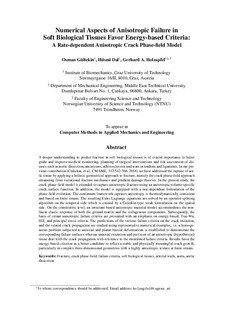| dc.contributor.author | Gultekin, Osman | |
| dc.contributor.author | Dal, Husnu | |
| dc.contributor.author | Holzapfel, Gerhard | |
| dc.date.accessioned | 2019-03-06T12:25:01Z | |
| dc.date.available | 2019-03-06T12:25:01Z | |
| dc.date.created | 2018-11-14T13:35:53Z | |
| dc.date.issued | 2018 | |
| dc.identifier.citation | Computer Methods in Applied Mechanics and Engineering. 2018, 331 23-52. | nb_NO |
| dc.identifier.issn | 0045-7825 | |
| dc.identifier.uri | http://hdl.handle.net/11250/2588995 | |
| dc.description.abstract | A deeper understanding to predict fracture in soft biological tissues is of crucial importance to better guide and improve medical monitoring, planning of surgical interventions and risk assessment of diseases such as aortic dissection, aneurysms, atherosclerosis and tears in tendons and ligaments. In our previous contribution (Gültekin et al., 2016) we have addressed the rupture of aortic tissue by applying a holistic geometrical approach to fracture, namely the crack phase-field approach emanating from variational fracture mechanics and gradient damage theories. In the present study, the crack phase-field model is extended to capture anisotropic fracture using an anisotropic volume-specific crack surface function. In addition, the model is equipped with a rate-dependent formulation of the phase-field evolution. The continuum framework captures anisotropy, is thermodynamically consistent and based on finite strains. The resulting Euler–Lagrange equations are solved by an operator-splitting algorithm on the temporal side which is ensued by a Galerkin-type weak formulation on the spatial side. On the constitutive level, an invariant-based anisotropic material model accommodates the nonlinear elastic response of both the ground matrix and the collagenous components. Subsequently, the basis of extant anisotropic failure criteria are presented with an emphasis on energy-based, Tsai–Wu, Hill, and principal stress criteria. The predictions of the various failure criteria on the crack initiation, and the related crack propagation are studied using representative numerical examples, i.e. a homogeneous problem subjected to uniaxial and planar biaxial deformations is established to demonstrate the corresponding failure surfaces whereas uniaxial extension and peel tests of an anisotropic (hypothetical) tissue deal with the crack propagation with reference to the mentioned failure criteria. Results favor the energy-based criterion as a better candidate to reflect a stable and physically meaningful crack growth, particularly in complex three-dimensional geometries with a highly anisotropic texture at finite strains. | nb_NO |
| dc.language.iso | eng | nb_NO |
| dc.publisher | Elsevier | nb_NO |
| dc.rights | Attribution-NonCommercial-NoDerivatives 4.0 Internasjonal | * |
| dc.rights.uri | http://creativecommons.org/licenses/by-nc-nd/4.0/deed.no | * |
| dc.title | Numerical aspects of anisotropic failure in soft biological tissues favor energy-based criteria: A rate-dependent anisotropic crack phase-field model | nb_NO |
| dc.type | Journal article | nb_NO |
| dc.type | Peer reviewed | nb_NO |
| dc.description.version | acceptedVersion | nb_NO |
| dc.source.pagenumber | 23-52 | nb_NO |
| dc.source.volume | 331 | nb_NO |
| dc.source.journal | Computer Methods in Applied Mechanics and Engineering | nb_NO |
| dc.identifier.doi | 10.1016/j.cma.2017.11.008 | |
| dc.identifier.cristin | 1630507 | |
| dc.description.localcode | © 2017. This is the authors’ accepted and refereed manuscript to the article. Locked until 2.11.2019 due to copyright restrictions. This manuscript version is made available under the CC-BY-NC-ND 4.0 license http://creativecommons.org/licenses/by-nc-nd/4.0/ | nb_NO |
| cristin.unitcode | 194,64,45,0 | |
| cristin.unitname | Institutt for konstruksjonsteknikk | |
| cristin.ispublished | true | |
| cristin.fulltext | postprint | |
| cristin.qualitycode | 2 | |

